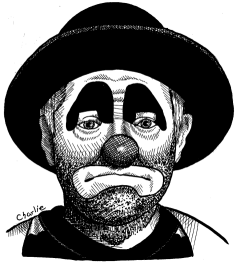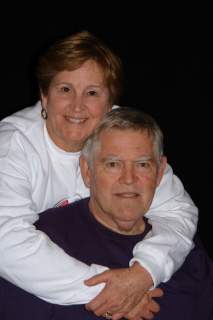Jim
Howle, Clown Artist
By
Bruce “Charlie” Johnson
While
growing up Jim Howle was interested in becoming either an artist or an
entertainer. Success did not come
easily to Jim, but he finally found it by combining his two interests to become
an artistic clown and a clown artist.
Jim
was born in
“As
for the ham in me, I was in all the class plays and programs – anything to get
out of class.”
What
Jim really wanted to do was get out of town.
His father’s store was at a cross roads, and the young boy would
imagine where those roads might lead him. The
possibility of travel was one of the allures of being an artist.
While reading Ernest Hemmingway’s Islands
in the Stream, Jim realized that it was possible for Hemmingway to live
in beautiful
After
graduating from High School, Jim entered the Ringling School of Art, founded by
John Ringling, in
Jim
gave up his dream of being an artist and tried to live a conventional life for
seven years. However, it didn’t
bring him happiness. After his first
marriage ended, Jim turned to his art and enrolled once again in the Ringling
School of Art. This time he
completed the course. Jim said,
“This time I was ready for the discipline.
I worked hard. I made progress and I was graduated.”
After
he was graduated by the art school in May, 1968, Jim decided to pursue his
other goal. He began working at two
jobs in
After
graduating from
During
his first two years touring with the RBB&B Circus, Jim set his art aside to
concentrate on developing his tramp clown character. During his first season
with RBB&B Circus Jim sat web, rode an elephant, appeared in production
numbers, and performed in the Fire House, the Clown Car, and a revival of Paul
Jung’s Sawing a Woman in Two. In
the sawing act, Duane Thorpe and Billy Ward were the magicians.
Jim was their lovely female assistant. After Jim was placed into the box,
he exited down into the base. Then
he boosted Prince Paul and Mike Paddilla, two little people, up into the box.
When the two halves of the box were separated and opened, the two little
people, one costumed as the woman’s torso and the other costumed as her skirt,
ran off in opposite directions. Jim
said, “I hated playing that role which is probably what made it so funny.”

Jim Howle
Illustration by Bruce "Charlie" Johnson
In
1970, Jim gradually returned to his art. He
bought a camera and an enlarger. Using
his knowledge of composition he began taking photos of other RBB&B Circus
performers that he sold to them for use in their publicity.
The only place he could find that would work as a dark room was the
donniker on the circus train. Even
there he had to drape a blanket over himself and his equipment to block out
light.
He
also began receiving commissions from other performers to paint their portraits.
Jim said he liked doing that because his subjects were “such
vibrant and colorful characters with lavish costumes.”
He began painting in conditions that would have discouraged less
dedicated artists. There wasn’t
enough room in his 8x11 foot room on the circus train to work there so he did
most of his work backstage where lighting was inadequate.
His colors came out muddied until he learned to compensate for the light
when mixing his paints. He didn’t
have an easel so he had to prop his canvass up on what was available.
He preferred working from life which meant he had to learn to work
quickly because his models were available only during brief periods between
acts. Jim said, “The critics were
something else. You had at least 250
experts looking over your shoulder, making comments in at least 18 languages.
But it was good! It had to
help me whether I wanted help or not.”
Jim’s
style evolved during this period and his painting improved.
He visited art galleries when he could to study what was being shown and
what type of work was selling. He
discovered that galleries liked larger oil paintings and that portraits seemed
to sell well. Jim had his first
one-man show at the Midtown Gallery in
Then
in 1975 Jim was named the RBB&B Circus Official Artist.
For a year he traveled with the show in a 32’ trailer.
His art was displayed in malls and department stores.
He conducted other on site publicity for the show.
At the end of the year, Jim left the circus.
Norman
Rockwell was one of Jim’s inspirations. When
Jim saw a touring exhibit of Rockwell prints at a shopping center, he decided
mall shows might be a good way to display his prints and get his career started.
Magicians
and other entertainers performing at malls would sit backstage between shows,
but the clowns with Button’s Clown Alley would stroll throughout the mall
entertaining the customers and inviting them to the next performance.
They also introduced themselves to the shop owners so they saw what they
were paying for. Button’s Clown
Alley eventually became a feature of the Beeker Kanter chain of malls and the
CBL mall chain. Jim’s 16 x 20
prints were hung on the front of the set. McBryde,
Anthony, Baxter, and Rouse appeared in the shows and were depicted in the prints
so the public could purchase a portrait of them after watching the performance.
Eventually
Jim and Leon split. Jim said he
might not have been doing enough to contribute to the shows.
Jim started his own similar mall show.
People who worked with Jim included Bob Baxter, Earl Chaney, Mark
Anthony, and Jonathan Wilkerson.
When
the mall shows ended, Jim continued performing as a freelance clown and working
on his art. He painted a portrait of
Lou Jacobs cuddling with his dog Knucklehead.
He created a triple portrait of Otto Griebling depicting him near the end
of his life after he had been diagnosed with cancer and at two earlier periods
of his life. Another of Jim’s
portraits was of Frankie Saluto. His
portraits documented the appearance of circus clowns, and his exhibitions kept
their memory alive.
Jim
joined the instructional staff of Clown Camp ® in 1987 and remained a part of
the program through 2009 when it concluded its traditional classes.
This program, founded and directed by Richard Snowberg, offered one-week
sessions of clown classes on the
During
some years Clown Camp ® had a special period when instructors with circus
experience cut up jackpots. Jim is
an outstanding story teller and contributed greatly to the success of these
sessions.
In
1988, Jim introduced a new series of numbered limited edition prints to document
the appearance of significant leaders in the art of clowning.
The series was called the Red Nose Philosophers.
Participants at Clown Camp ® voted on instructors they felt should be
added to the series. Each print was
accompanied with a one page biography of the subject.
Individual prints could be purchased, but those who bought the entire set
received a scrapbook Jim designed with pages for mounting the prints facing
pages with the subject’s biography. During
a period of five years, eleven clowns received the Red Nose Philosopher honor.
Those with circus experience are Barry “Bonzo” DeChant, Patricia
“Priscilla Mooseburger” Manuel Bothen, Arthur “Vercoe” Pedlar, Jim Howle,
Steve “T J Tatters” Smith, Bruce “Charlie” Johnson, and Kenny Ahern.
The other three in the series are Richard “Snowflake” and
“Junior” Snowberg, Lee “Juggles” Mullally, and Dorothy “Blab-a-gale”
Miller.
When
the International Clown Hall of Fame inducted their first group of clowns in
1989, they asked Jim Howle to design a special poster for the occasion.
Jim’s painting, titled Pit Stop, depicted Emmett Kelly, Otto Griebling,
Mark Anthony, Red Skelton, and Felix Adler clustered around Lou Jacobs exiting
his little car. Jim designed the
1990 ICHOF poster, titled “Wall of Fame,” which depicts pictures of the
three inductees, Leon McBryde, Bob Keeshan, and Joseph Grimaldi, posted on the
wall of a typical clown’s dressing room. His
painting for the 1991 ICHOF poster depicted Bobby Kaye, Frankie Saluto, Michael
“Coco” Polakov, Glen “Frosty” Little, and Dan Rice.
After a period when other artists created the ICHOF posters, Jim designed
the 1999 ICHOF poster depicting Bill Irwin, Richard “Snowflake” Snowberg,
Charlie Rivel, Bob “Hambone” Hamilton, and Umberto “Antonet” Guillame.
An
artist analyzes their subjects. Jim’s
observations while painting famous and significant clowns, combined with his own
aesthetic sense developed as an artist, made him an expert on clown make up
design. He began offering a service
he called It’s Your Face. He would
spend time getting to know a person and their needs, and then create a make up
design specifically for them. For
example, Richard Snowberg was originally a whiteface clown.
When a medical condition meant he could no longer wear make up next to
his eyes, Jim created an auguste make up design for Richard that disguises the
fact that he has bare skin around his eyes.
Jim designs faces for hundreds of clowns each year.
Jim’s
wife, Maybelle, has worked with him during the It’s Your Face sessions.
She would video tape the session so their customer went home with a
record of how Jim applied the make up to their face.
She is a charming southern lady and they are a much loved couple in the
clown community.

Jim and Maybelle Howle
Photo by Merilyn Barrett, Courtesy of Clown Camp
In
connection with his design service, Jim introduced his own brand of make up and
artificial noses. Continuing the
philosophy that he learned at the Ringling School of Art Jim has worked hard to
continually improve upon his products, in particular his noses.
Jim
has continues to produce new portraits. Some
of them are original works that are done on commission.
Others are new additions to his line of prints.
In 2009 and 2010 three of Jim’s portraits appeared on covers of Clowning
Around magazine published by the World Clown Association.
Through
his work as a portrait artist Jim is documenting the current state of the art of
clowning for study by future circus historians.
Through his work as a performer, instructor, and make up designer Jim is
helping to shape the future of the art of clowning.
In recognition of his contributions to clowning, Jim was inducted into
the International Clown Hall of Fame in 1994.
In 2010 he received the World Clown Association President’s
Humanitarian Award in recognition of his continued contributions.